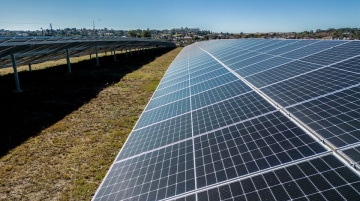
One of China’s biggest companies, the Fortune 500-listed PowerChina, is establishing itself among energy sector players seeking to offer solutions to the crippling blackouts predicted to last until 2027 in South Africa.
The country is seeking to transition to a greener manufacturing economy by increasing energy generation from renewables in addition to coal-fired plants and other power sources. China has agreed to partner in these efforts to industrialize South Africa further, according to the country’s Trade, Industry and Competition Minister Ebrahim Patel.
To complement these efforts, renewable power plants are coming up in different parts of the country and PowerChina, the state-owned Chinese energy behemoth, is taking advantage of this to expand its footprint in the sector after signing a contract for the second-largest solar energy plant in South Africa.
PowerChina will build, operate and maintain a 123MW solar plant that will provide electricity to at least 82,000 households when completed. While this is not a huge project, the additional power generation will no doubt offer relief to residents from the almost two-decade-long electricity supply crisis, commonly known as load-shedding.
The facility will be the company’s second renewable energy initiative in South Africa. Earlier, PowerChina was contracted to build a 100mw solar plant in the Northern Cape region funded by the African Development Bank.
South Africa’s Challenges Shifting From Coal to Renewables
Aging and failing coal-powered plants, limited investments in alternative energy sources, corruption and vandalism of electricity transmission systems only add to compound the current load-shedding problems.
While increased electricity generation is good for communities enduring load-shedding, renewables may not address all of their economic woes. The coal sector employs at least 200,000 workers and fears that a green energy transition will cause mass layoffs make opposition from workers’ unions highly likely.
Cobus van Staden, CGSP managing editor and a senior researcher in South Africa says: “By coal making up a large part of South Africa’s exports and players being politically powerful (both as investors and unions), the full phasing out of the fossil fuel and transitioning to renewable energy will be an enormous challenge.”
He adds that coal bias within the South African government is significant which will possibly give a lease of life to hydrocarbon lobbies and delay the green transition.
As the continent’s most industrialized country, South Africa currently generates 42,000MW from coal-fired plants, accounting for about 85% of the electricity output. A surprise announcement in June 2021 by President Cyril Ramaphosa which eased licensing regulations for independent power producers enables them to generate up to 100MW each which collectively will add as much as 5,000MW to the grid by 2024.
The country targets to increase renewable energy generation to 41% by 2030 and Chinese companies like PowerChina are well positioned to contribute to this transition.
Van Staden adds, “From this perspective, China could influence South Africa’s direction by offering technical assistance, connections to appropriate providers of renewables and related engineering, procurement, and construction services.”
WHY IS THIS IMPORTANT?
The PowerChina project is not big in size in comparison to other mega developments but it is significant to South Africa’s local energy sector transformation. It adds to the pace of renewables adoption in the country.
South Africa’s power utility, Eskom, plans to close seven coal plants by the end of 2030 and two more by 2035, out of a total of 15. With this closure, PowerChina and other Chinese companies are in an advantageous position to snap the available sustainable energy generation opportunities in the country.
Already other Chinese companies like Sinohydro Corporation, China Yangtze Power, Xinjiang Goldwind Science Technology and JinkoSolar Holdings have some solar power projects in their portfolio in South Africa which gives them an edge in the country’s renewables sector.
SUGGESTED READING:
- Crisis42: South Africa: Load shedding likely to occur regularly through 2023 /update 2
- Mail&Guardian: ‘Load-shedding will continue until 2027’ by Mandisa Nyathi









